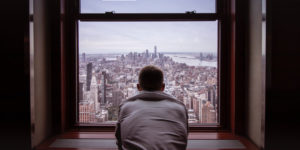











Aerophobia is a type of specific phobic disorder that is characterized by dread and an intense fear of flying. Specific phobias are a category of anxiety disorders in which people experience irrational and intense fear in response to certain objects and situations. A person suffering from aerophobia will feel extremely anxious when thinking about or anticipating flying.

While flying, individuals with aerophobia often experience panic attacks and other anxiety symptoms. They may decide to stop flying altogether in order to avoid aversive symptoms. A fear of flying can cause significant amounts of distress and harm a person’s quality of life.
Airports are places of organized chaos and a fantastic location to do some serious people-watching. At any point throughout the day, you will notice businessmen and women moving hurriedly throughout the airport, briefcases in hand. You will see family members arriving and embracing loved ones that they have not seen in months. If you look closely and pay attention, you will also see some individuals who are pale with stricken looks on their faces. These people look like they are going to be physically sick at any moment and pace around departure gates with scary amounts of nervous energy. They can be seen trying to cope in any way possible, whether they are trying to talk themselves down, having a pre-flight cocktail, or praying to some higher power. These individuals have aerophobia or a fear of flying.
Aerophobia can present by itself or in conjunction with other phobias. Some other phobias that frequently accompany aerophobia include a fear of vomiting, a fear of heights, or a fear of enclosed spaces. Treating these other phobias first may result in alleviating the symptoms of aerophobia.
An individual may have a genetic predisposition to a fear of heights, or the fear can develop through trauma or some other negative experiences or associations. Parents who are afraid to fly can inadvertently teach their children that flying is scary by modeling these emotions for them. A person may also develop a fear of flying after experiencing a traumatic flight or plane crash, or simply from watching news telecasts that show plane crashes or plane malfunctions.
Individuals most commonly fear flying because they feel a lack of control regarding their safety. Travel delays, turbulence, and other factors can intensify a fear of flying.
Those with aerophobia may experience symptoms thinking about flying, before boarding a plane, or while they are actually in flight. Symptoms can include:
Different people experience different sets of symptoms and with different levels of intensity. In general, with specific phobias, the severity of the symptoms depends on the proximity to the triggering object, in this case, an airplane or airport.
According to the Diagnostic and Statistical Manual of Mental Disorders (DSM-V), having a phobia requires certain criteria to be met, and being scared of something does not necessarily mean that one has a phobia. The criteria include:
Thankfully, the fear of flying is treatable. A person can stop the fear of flying by identifying their phobia, obtaining knowledge to challenge irrational thought patterns, and setting personal travel goals to practice flying, all in consultation with a mental health professional.
Aerophobia can be treated with medication, therapy, or a combination of both. Anti-anxiety medication may be prescribed to help people reduce their physical symptoms of anxiety. One therapy modality that is commonly used for treating aerophobia is exposure therapy, which entails gradually helping a person adjust to thoughts and sensations related to flying by desensitizing them to the triggers of aerophobia over time until they no longer cause them to panic.
Another popular therapeutic treatment is cognitive behavioral therapy, which seeks to help an individual alter irrational thought patterns about flying in order to help them change their behaviors. Hypnotherapy and virtual reality techniques can also assist a person in overcoming their fear of flying.
Aerophobia is a common condition that may be overcome with some work. The symptoms themselves and the disruption they can cause vary between different people as some people experience harsher symptoms than others and for some flying is a regular part of their lives. If you feel that aerophobia is something worth addressing, it’s best to find a mental health professional who can help you overcome your fears and minimize your anxiety.
Sources